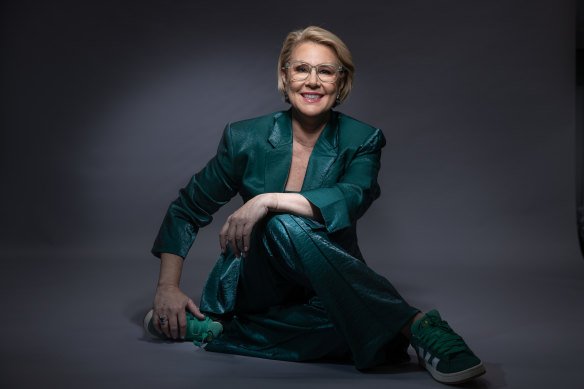When Sarah Hayden was diagnosed with ADHD, aged 48, many things fell into place. For one, she understood her uncanny ability to do a vast volume of things at once, and why she easily gets bored.
Like many women diagnosed in midlife with one of the most common neurodevelopmental disorders, she also began to understand the battles she faced as a girl.
“I shed quite a few tears and kind of looked back on my life and how I really struggled at school,” says Hayden, a social worker and equine-assisted psychotherapist who works with neurodivergent girls and is a mother of five, foster mother of 55, and the new mayor of Golden Plains Shire in Victoria.
Loading
“I forgot everything, lost everything, never handed in assignments because, though I’d been in the class, I didn’t remember anything about them and wondered how other kids knew this was due.
“I drifted from friend group to friend group and couldn’t sustain friendships. And it was really difficult in the years post-leaving school, I just kept going from degree to degree. This happened not once or twice, but maybe a dozen times – my HECS debt was unbelievable.”
One benefit of her “superpower” is Hayden’s longstanding ability to cram a lot in; she wrote her forthcoming book on raising neurodivergent kids, Parenting Different, in grabs of time between the hours of 10pm and 1am.
“My whole life, I’ve multitasked and done a million things at the same time. I hate boring – I could never do it,” she says.
Hayden is among a wave of midlife Australian women whose neurodiversity was missed when they were children. She describes what she now knows to be ADHD as feeling “like my brain permanently has 50 tabs open”.
Actor Chloe Hayden, Sarah Hayden’s daughter, received an ADHD diagnosis at 22.Credit: Jason South
She only realised she might have the highly inheritable condition while sitting through tests for it with her eldest daughter, award-winning autistic actor Chloe Hayden.
Chloe, a star of the rebooted Heartbreak High, was diagnosed with autism at 12 and – quite unexpectedly – with ADHD at 22. As her mother read questions in Chloe’s assessment, she recognised her own symptoms.
When her symptoms grew more prominent in perimenopause, Sarah Hayden sought assessment. She discovered she had ADHD. “I got an A-plus on my ADHD test,” she says.
Hayden has joined a fast-growing group of women being diagnosed in adulthood, including director Greta Gerwig, celebrity Paris Hilton, actor and singer Lily Allen and actor Rachel Griffiths.
Pharmaceutical Benefits Scheme data released in 2024 showed the number of adults using ADHD medications rose by 450 per cent in the 10 years to 2022-23, and – as female diagnosis caught up – more women (52 per cent) than men were being treated for it.

TV host and comedian Julia Morris revealed on air in January that she had recently been diagnosed with ADHD.Credit: Simon Schluter
In January, TV presenter and comedian Julia Morris revealed her recent diagnosis, saying she decided to speak about it after seeing actor Sigrid Thornton (diagnosed in late 2024) and comedian Geraldine Hickey also reveal they had learnt of their diagnoses.
Thornton described the symptoms, including not being able to follow through on her intentions with her loved ones, as “a source of my shame” because she could not keep up with demands.
Two weeks ago, comedian and actor Celeste Barber opened up on the ABC’s Australian Story about living with ADHD since childhood and the immense challenges it creates.
Actor Sigrid Thornton has said the symptoms of her ADHD had been “a source of shame”.Credit: Wolter Peeters
Emotions such as grief, relief and self-acceptance or validation are common among women diagnosed with ADHD, say Australian researchers studying the impact of midlife diagnosis, including the University of Queensland’s Dr Kate Witteveen.
Many women have flown under the radar in their formative years because diagnostic criteria for ADHD – including physical hyperactivity and impulse control – were based on those exhibited by boys. Girls may be seen as dreamy, unfocused or disorganised.
Girls and women were also under-represented in ADHD research, says Witteveen, who is helming one of several Australian studies into adult female diagnosis.
“The way a lot of these women are getting diagnosed is an external catalyst: a child, sibling or friend being diagnosed, or a significant mental health event,” she says. “Often they reach perimenopause and all their coping strategies are not as effective any more.
“There may be breakdown and burnout, where people are reaching a point where they cannot cope as they have been.”
A notable increase in ADHD diagnoses among women since the pandemic was likely due to the new stressors, such as home-schooling, upping pressure. “This extra cognitive load was certainly a catalyst for a lot of people,” Witteveen says.
Many have learnt how to appear to conform to societal expectations, Witteveen and other researchers say, in a phenomenon known as “masking”.
Another reason ADHD can go undetected in girls is that while boys often externalise their hyperactivity, in girls and women, the condition can “show up as a busy brain; that energy is internal”, she says.
As understanding of female ADHD and autism increases, the jump in diagnosis is a “correction”, Witteveen says, and not, as some claim, primarily down to TikTok influencers making neurodiversity fashionable.
‘There is a greater sense of self-acceptance, this relief of starting to understand a sense of ‘who I am’ and starting to love that person.’
Professor Katherine Johnson, University of Melbourne
Her research, due out soon, will note that the vast majority of women who are eventually discovered to have ADHD had been diagnosed when younger with anxiety, which “overshadowed” the underlying condition.
“They are actually anxious, but also because they’re living with undiagnosed ADHD,” she says. “This [late diagnosis] is another symptom of the data-gap more broadly in terms of women and health.
“A concern people have raised is the risk of over-diagnosis, and participants [in her study] were talking to me about some of the things they often hear, like, ‘Everybody’s got ADHD and it’s trendy’. But no one’s getting diagnosed with ADHD on a whim.
“It’s expensive, time-consuming and quite a significant commitment … a lot of people talked about getting dismissed, they went in very well-prepared and had done their homework and had to make a case with their GPs just to get the referral.
“This is certainly not something you do just because your friend’s done it. What we’re seeing is a time of correction of under-diagnosis [of girls and women] rather than going too far in the other direction.”
Sarah Hayden and youngest daughter Fen, 12, with therapy pony Charlotte.Credit: Chris Hopkins
Katherine Johnson, a professor in the University of Melbourne’s School of Psychological Sciences and the director of its Attention Dynamics Lab, is also researching adult diagnosis of ADHD and says the way people feel about themselves when they receive a long-overdue diagnosis often markedly improves.
“There’s a greater sense of control over their lives, and that will increase the wellbeing of a person,” Johnson says. “There is a greater sense of self-acceptance, this relief of starting to understand a sense of ‘who I am’ and starting to love that person.”
Their relationships may also benefit, as well as their “social and emotional wellbeing”.
Loading
Johnson says various therapies are useful for people whose ADHD is identified, but that cases are still being missed, especially among girls.
About 8 per cent of Australian school-aged children are estimated to have the condition, she said, and among those, 60 to 85 per cent will have symptoms that persist into adulthood.
While similar rates of men and women experience ADHD symptoms as adults, the diagnosis rate among children is still three boys for every girl, which means “we are still missing lots of girls right now”, says Johnson.
Sarah Hayden hopes the openness of high-profile women speaking up about their conditions and symptoms will help to reduce judgment, scepticism and stigma, and pave the way for recognition of other girls.
“It’s just nice that people are not feeling ashamed to come out and talk about it,” she says. “It is opening up those conversations for other people, making them feel OK.”
Sarah Hayden’s book, Parenting Different, will be released on March 4.
Make the most of your health, relationships, fitness and nutrition with our Live Well newsletter. Get it in your inbox every Monday.
Read the full article here
